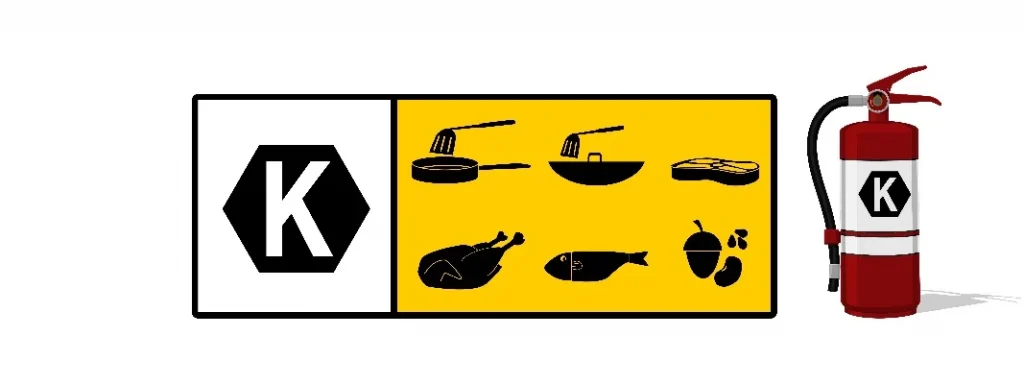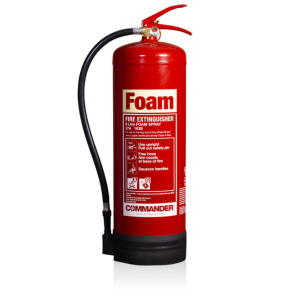What Do the Symbols on a Fire Extinguisher Indicate? Understanding Fire Safety Labels
Fire extinguishers are essential tools in maintaining fire safety. Recognizing the symbols on a fire extinguisher can make the difference between effectively putting out a fire and accidentally making it worse.

Each symbol provides critical information about the types of fires the extinguisher can combat.
For instance, a green triangle with an "A" indicates it's suitable for ordinary combustibles like wood and paper, while a red square with a "B" is for flammable liquids.
Understanding these symbols ensures you choose the right extinguisher in an emergency, enhancing your ability to protect your home or workplace.
Moreover, the numbers that sometimes accompany these letters (like "2A" or "10B") indicate the capacity or effectiveness of the extinguisher. A higher number implies better performance for that particular fire class.

This straightforward yet crucial knowledge equips anyone with the know-how to respond better in a fire emergency.
Key Takeaways
- Fire extinguisher symbols indicate the types of fires they can combat.
- Numbers next to symbols show the extinguisher's effectiveness.
- Knowing these symbols helps ensure proper fire safety measures.
Understanding Fire Classes
Fire extinguishers are classified based on the types of fires they are designed to combat. Recognizing these fire classes helps in choosing the right extinguisher for specific fire scenarios, ensuring effective and safe fire suppression.

Class A: Combustibles
Class A fire extinguishers are intended for fires involving ordinary combustibles. These include wood, paper, cloth, and certain plastics.
The symbol for Class A is a green triangle with the letter A inside. Often, a pictogram displays a trash bin and firewood burning.
This class uses water or foam extinguishers, which cool the fire and soak the material to prevent rekindling.

Class B: Flammable Liquids
Class B fire extinguishers are designed for fires involving flammable liquids. These include gasoline, oil, grease, alcohol, and paint.
The symbol for Class B is a red square with the letter B. A pictogram of a fuel can on fire represents this class.
Extinguishers for this class often use foam, carbon dioxide (CO2), or dry chemical agents to smother the flame and cut off the oxygen supply.

Class C: Electrical Fires
Class C fire extinguishers target fires that involve live electrical equipment, such as wiring, circuit breakers, appliances, and electrical panels.
The symbol for Class C is a blue circle with the letter C. A pictogram displays an electrical plug and outlet.
Since water can conduct electricity and worsen the situation, non-conductive agents like CO2 or dry chemicals (like monoammonium phosphate) are used in these extinguishers.

Class D: Combustible Metals
Class D fire extinguishers are used for fires sparked by combustible metals. Common examples include magnesium, titanium, potassium, and sodium.
The symbol for Class D is a yellow star with the letter D. A specific pictogram showing a burning metal element may represent this class.
Class D extinguishers use dry powdered agents, like sodium chloride or graphite, which work by absorbing heat and smothering the fire, specifically tailored for metal fires.

Class K: Kitchen Fires
Class K fire extinguishers are meant for fires involving cooking oils and fats, typically found in commercial kitchens. These involve vegetable oils, animal fats, and greases.
The symbol for Class K is a black hexagon with the letter K. A pictogram usually shows a frying pan on fire.
Extinguishers for this class use wet chemical agents, like potassium acetate, which cools the fire and creates a barrier between the fuel and the oxygen, effectively preventing re-ignition.
Types of Fire Extinguishers
Fire extinguishers are categorized based on the types of fires they can extinguish. Each uses different chemicals or substances to handle specific kinds of fires safely and effectively.
Water Extinguishers
Water extinguishers are ideal for fires involving ordinary combustibles like wood, paper, and cloth. These are classified as Class A fires.
Water extinguishers work by cooling the burning material, reducing the heat, and ultimately putting out the fire.
They are easily recognizable by their red body and the label showing a wood fire symbol.
Do not use water extinguishers on electrical fires or fires involving flammable liquids, as water can conduct electricity and spread the flames.

Foam Extinguishers
Foam extinguishers are effective on fires involving flammable liquids such as petrol or oil (Class B fires).
They work by covering the liquid with a blanket of foam, cutting off the oxygen supply, and extinguishing the fire.
These extinguishers are also somewhat effective on Class A fires.
They are identified by a cream label. Unlike water extinguishers, foam can help prevent re-ignition, but they should not be used on electrical fires unless they are specified to be safe for such use.

Dry Powder Extinguishers
Dry powder extinguishers can handle various fire types, including Class A, B, and C fires.
They use a fine chemical powder that smothers the fire, cutting off the oxygen supply.
These are versatile and can even be used on electrical fires, although they leave a residue that can harm sensitive equipment.
The label is usually blue. While effective, they may not cool the fire sufficiently, risking re-ignition.

Carbon Dioxide Extinguishers
Carbon dioxide (CO2) extinguishers are ideal for electrical fires and are also suitable for Class B fires.
They work by displacing the oxygen surrounding the fire and cutting off the air supply.
CO2 extinguishers do not leave any residue, making them perfect for use in offices or places with a lot of electronic equipment.
They can be identified by their black label. However, they have a short range and can be less effective in windy conditions.

Wet Chemical Extinguishers
Wet chemical extinguishers are designed for Class K fires, typically involving cooking oils and fats.
They release a fine mist that cools the flame and reacts with the oil to form a soap-like solution, which seals the surface and prevents re-ignition.
These extinguishers can also be used on Class A fires.
They have a yellow label, are highly effective in commercial kitchens, and ensure the fire does not reignite.
They must be used cautiously to avoid splashing the burning oil.
Fire Extinguisher Symbols and Labels
Fire extinguishers have specific symbols and labels to indicate their appropriate use. Understanding these symbols ensures you choose the right extinguisher during an emergency.
Pictograms and Color Coding
Symbols on fire extinguishers are often represented as pictograms. These pictograms help quickly identify the type of fire the extinguisher can put out.
- Class A: Represented by a trash can and wood, for ordinary materials like paper and wood. Typically, these have a green triangle.
- Class B: Shown with a gasoline can, for flammable liquids like gasoline or oil. These are marked with a red square.
- Class C: Depicted with an electrical plug and outlet, for electrical fires. These have a blue circle.
- Class D: Usually shown with a gear or star, for flammable metals. These use a yellow star.
- Class K: Represented by a frying pan, for kitchen fires involving grease and cooking oils. These are indicated with a black hexagon.
Color coding of fire extinguishers further helps in quick identification.
Rating Numbers and Size
Fire extinguishers also have rating numbers that show their effectiveness.
- Class A Ratings: Numbers indicate the water equivalency. For example, "2A" means it has the extinguishing power of 2.5 gallons of water.
- Class B Ratings: Numbers indicate the area of fire it can extinguish. For example, "10B" means it can cover 10 square feet.
- Class C, D, and K: These classes do not have numeric ratings. Instead, they rely on symbols to show they are suitable for electrical, metal, or kitchen fires, respectively.
Size matters too. Larger numbers generally mean more fire-fighting capacity.
Correct Usage of Fire Extinguishers
Properly using a fire extinguisher can save lives and prevent property damage. Key points include understanding how to operate the extinguisher, applying the PASS method, and knowing when it's necessary to evacuate and call 911.
Operating Instructions
Each fire extinguisher comes with detailed operating instructions that should be followed carefully.
First, ensure the extinguisher is appropriate for the type of fire you are facing. Check the labels and symbols to confirm this.
Before using it, hold the extinguisher upright and remove the safety pin or clip. This will unlock the operating lever.
Stand back about 8-10 feet from the fire to maintain a safe distance.
Aim the nozzle or hose at the base of the fire.
Squeeze the lever slowly to discharge the agent. Continue aiming at the base, where the fuel source is, to effectively put out the flames.
Move closer as the fire diminishes.

The PASS Method
The PASS method provides a simple way to remember the four steps needed to operate a fire extinguisher effectively. PASS stands for Pull, Aim, Squeeze, and Sweep:
- Pull the pin: This step breaks the tamper seal and allows the handle to be released.
- Aim low: Point the nozzle or hose at the base of the fire where the fuel is.
- Squeeze the handle: This releases the extinguishing agent.
- Sweep side to side: Move the nozzle from side to side until the fire is completely out.
If the fire re-ignites, repeat these steps. Always aim at the base to cut off the fire's fuel source.
When to Evacuate and Call 911
Even when a fire extinguisher is used correctly, there are times when it's best to evacuate and contact emergency services immediately.
If the fire is spreading rapidly or seems too large to handle, prioritize safety and exit the building.
Call 911 from a safe location to report the fire. Ensure everyone is accounted for and safely outside.
Do not return to the building until it's declared safe by authorities.
Knowing when to leave and seek professional help can prevent injuries and potentially save lives.
Teach family members and colleagues these steps to ensure everyone is prepared in an emergency.
Fire Extinguisher Maintenance and Inspection
Maintaining and inspecting fire extinguishers ensures they work properly during an emergency. Key points include regular inspections, monitoring expiration dates, and professional maintenance.
Regular Inspection
Regular inspection of fire extinguishers is essential.
Check monthly to confirm they are easily accessible, not blocked by objects, and the pressure gauge shows the correct pressure.
Make sure the pin and tamper seal are intact.
Inspect the hose and nozzle for any cracks or damage. Look for any signs of corrosion, leakage, or physical damage.
Document each inspection in a logbook with the date and findings.
Proper routine checks ensure the extinguisher is ready for use when needed.
Training on how to perform inspections can help identify issues early and maintain safety.
Expiration Date and Replacing Extinguishers
Fire extinguishers have expiration dates. Check the label for the manufacture date and lifespan, typically between 5 to 15 years.
An expired extinguisher may not function correctly and can be unsafe.
Replace extinguishers when they expire. Also, replace them if they are damaged or have been partially discharged.
Always choose replacements based on the type of fire it is meant to fight.
Properly dispose of old or expired extinguishers according to local safety regulations.
Ensuring all extinguishers are within their valid dates maintains fire safety readiness.
Professional Maintenance
Professional maintenance is necessary for fire extinguishers.
Experts perform annual checks that include a thorough examination, testing, and refilling if needed.
Hydrostatic testing, done every 5 to 12 years, checks for structural integrity and pressure retention.
Certified professionals should handle any repairs.
They ensure the extinguisher meets safety standards and remains effective.
Professional services might include detailed inspection reports and safety advice.
Employ certified technicians for this role. Regular professional maintenance complements everyday inspections and guarantees the extinguisher's reliability.
Identifying the Correct Fire Extinguisher
Selecting the right fire extinguisher is crucial to efficiently and safely putting out a fire. It is important to consider the fire class and the environment where the extinguisher will be used.
Based on Fire Class
Fire extinguishers are divided into different classes based on the type of fire they can extinguish. Each class has specific symbols and colors:
- Class A: Used for ordinary combustibles such as wood, paper, and cloth. The symbol is a green triangle.
- Class B: Designed for flammable liquids like gasoline, oil, and paint. The symbol is a red square.
- Class C: Suitable for electrical fires involving live electrical equipment. The symbol is a blue circle.
- Class D: For fires involving flammable metals like magnesium and sodium. The symbol is a yellow star.
- Class K: Targets fires in cooking appliances involving vegetable or animal oils and fats. The symbol is a black hexagon.
Knowing these symbols helps in quickly identifying the correct extinguisher during an emergency.
Specialized Environments
In specialized environments, different types of fire extinguishers might be more suitable. For instance:
- Industrial Settings: They often have a high risk of Class D fires, where metal fires could occur. A Class D fire extinguisher is essential in these environments.
- Kitchens: Class K extinguishers are vital in commercial kitchens. These extinguishers effectively handle fires involving cooking oils and fats.
- Offices: Class A, B, and C extinguishers are commonly used. These settings can have a mix of electrical equipment, paper, and flammable liquids, making multipurpose (ABC-rated) extinguishers practical.
Understanding the fire risks in specific environments ensures that the correct fire extinguisher is always at hand.
Fire Safety and Prevention Tips
Preventing fires is essential for maintaining safety in homes and workplaces. Understanding common fire hazards and how to respond effectively can save lives and property.
Creating a Safe Environment
Keeping your environment safe means identifying and eliminating fire hazards.
Combustible materials like paper, textiles, and chemicals should be stored properly.
Ensure that electrical equipment is regularly inspected and wiring is not frayed.
The fire triangle—heat, oxygen, and fuel—can help people understand how fires start.
Reducing any side of the triangle can prevent fires.
For instance, keeping cooking areas free of grease and flammable materials can prevent a grease fire.
The NFPA provides guidelines on keeping spaces safe. They recommend smoke alarms in every room and regular drills to ensure everyone knows the evacuation plan.
Responding to Fires
Quick and appropriate action can limit damage and save lives.
First, activate an alarm and call emergency services.
If the fire is small, use the correct extinguisher.
Class A extinguishers handle common materials like wood and paper. Class B extinguishers are for flammable liquids, while Class C extinguishers deal with electrical fires.
Remember to maintain extinguishers regularly and ensure they are easily accessible.
If the fire cannot be controlled, evacuate immediately.
Close doors behind you to contain the fire and reduce oxygen supply, following the principles of the fire triangle.
Frequently Asked Questions
Different symbols on a fire extinguisher indicate the classes of fire they are suitable for. Understanding these symbols ensures you choose the correct extinguisher type for specific fires, enhancing safety during emergencies.
What does the letter B on a 5 fire extinguisher indicate?
The letter B on a fire extinguisher indicates it is suitable for flammable liquid fires, such as grease, gasoline, and oil.
Which of the following is a good technique when using a fire extinguisher?
Use the PASS technique: Pull the pin, Aim the nozzle at the base of the fire, Squeeze the handle, and Sweep the nozzle from side to side.
All fire extinguishers are labeled with a letter and a number; what does the number indicate?
The number on a fire extinguisher label indicates the size of fire it can extinguish. For example, a 5 rating means it can handle a 5-square-foot fire.
The letter on a fire extinguisher label represents how much water the extinguisher contains: is this true?
No, the letter on a fire extinguisher label represents the class of fire it is designed to fight, not the amount of water it contains.
Which class of fire extinguisher should be onboard a vessel with a permanently installed fuel tank?
Class B fire extinguishers should be onboard vessels with permanently installed fuel tanks, as they are suitable for flammable liquid fires.
Why are there pictograms on the fire extinguisher label?
Pictograms on fire extinguisher labels quickly show the types of fires the extinguisher can handle. This makes it easier to choose the right one in an emergency.
Charlie is Editor-in-Chief of Sea Magazine







